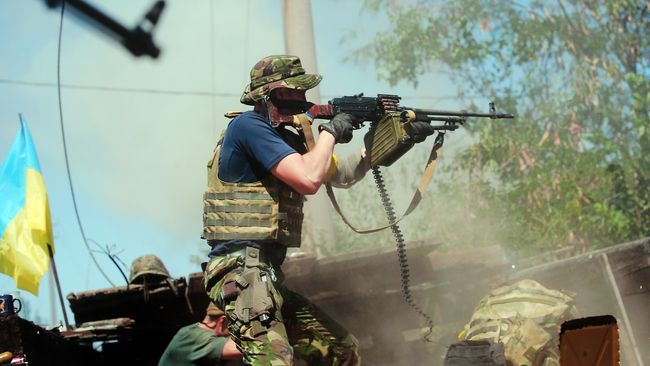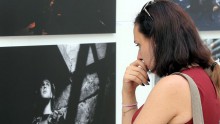The “Ilovaisk” photo exhibit is very simple. The room at the Shevchenko Museum, an atrium with a glass roof, over 60 color and black-and-white photos, and captions written by authors themselves. The authors are four: Oleksandr Hliadielov, Maksym Dondiuk, Maksym Levin, and Markiian Lyseiko. The photos are all about the war. Soldiers before an assault, after breaking through the encirclement, during a halt, busy planning operations, vehicles on the move, vehicles destroyed and burnt. Some of the men in the pictures were killed short afterwards. Some survived and got demobilized. Some are still being treated for their wounds. Others are still on the front line. The authors issued a brief press release saying:
“We survived where others died. We remember, and cannot let this slip into oblivion. We are waiting for justice.”
In collective perception, Ilovaisk is gradually taking the same shape as any other important battle, no matter if it was victory or defeat. It is rapidly turning into a myth, together with all its causes, consequences, and the losses suffered in the operation. This is how human conscience works. The history of any country has been permeated with myth from the very start. Exhibits like this one will hardly stop the process. But they can create a decent counterbalance.

AUGUST 17, 2014. FIGHTING IN THE VILLAGE OF HRABSKE DURING THE ASSAULT ON THE CITY OF ILOVAISK. PICTURED RIDING AN ARMORED KRAZ TRUCK: “APONCHYK” (OLEKSANDR APONCHUK), SOLDIER, MEDIC RIFLEMAN OF THE 5th SQUAD, THE 3rd PLATOON, THE 2nd ASSAULT COMPANY, THE NATIONAL GUARD OF UKRAINE COMMANDO BATTALION “DONBAS.” HE WAS WOUNDED IN ILOVAISK WHILE MOPPING UP THE CITY WATER MAINS OFFICE, AND EVACUATED WITH OTHER WOUNDED. HE HAS RETURNED TO SERVICE. PHOTO BY MAKSYM DONDIUK ©
These pictures are the question and the answer in themselves, because they hold the truth of characters and situations, the truth of glances and gestures. Without unnecessary affectation and exaggeration, together the works of all four photographers (from Dondiuk’s photo of a classroom board with the text “08.21.2014 Soldiers of the 3rd Special Purpose Battalion ‘Donbas’ held the line here. We are fighting and dying so that you could live in peace!” to Hliadielov’s black-and-white photo of an exhausted calf seeking shelter in the shade of a crushed tank) create an image of Ilovaisk as a formidable collision of people’s fates and the carnage of war.

AUGUST 26, 2014. A MOPPING-UP OPERATION IN A LOW-RISE AREA, THE BATTLE FOR THE 2nd CHECKPOINT. PICTURED STANDING UPRIGHT WITH A MACHINE GUN: PAVLO PETRENKO, CALLSIGN “BANNI,” A FEARLESS WARRIOR. HE WAS KILLED DURING THE BATTLE IN CHERVONOSILSKE, RIDING A FIRE TRUCK WITH SOLDIERS KNOWN BY CALLSIGNS “TUR” AND “VOSMY.” THE TRUCK RECEIVED A DIRECT HIT FROM A TANK GUN. THE SOLDIER LAYS BURIED IN THE CITY OF ZDOLBUNIV, RIVNE OBLAST. PHOTO BY MAKSYM LEVIN ©
The Day asked one of the photographers, Maksym DONDIUK, to tell more about the exhibit and the history of its origin.
How do you assess those events now?
“I don’t think that the events in Ilovaisk were the most tragic. We simply happened to witness them. But there were no photographers at Savur-Mohyla, and we still do not know what was going on there. On the other hand, while we were in Ilovaisk, all the media and the ATO press service were painting a totally different picture. Sadly, it lasted all the summer last year and still repeats itself now, because people here are absolutely ignorant about what is happening there.”
Were these photos published before?
“A lot of them have been printed for the first time. I waited a year before publishing them because many of those guys were PoWs. Actually, we could not afford publishing these pictures for some ephemeral fame while they could harm someone. ‘Do not harm’ is the most important rule of journalism, which reporters forget too often. They absolutely do not care what awaits the subject of their photo-, video story, or of an interview.”

MAKSYM DONDIUK AND OLEKSANDR HLIADIELOV
Oleksandr Hliadielov also spoke bitterly about the bitter lack of objectivity and professionalism in Ukrainian mass media during the operation. Was it really that bad?
“They were lying a lot. Black and white. It was absolutely contrary to our facts. Just the other way around. I even never read news from the front if it does not come from a journalist I trust, who reports immediately from the site, because I do not trust the rest of them. Sometimes Ukrainian media are no better than Russia Today. I do not know why. Unfortunately.”
How did you manage to evacuate?
“I kept filming till my camera broke. Literally in a couple of days I had an exhibit in France, I already had plane tickets, so I had to get out before August 29. I went together with one wounded. He was from Dnipropetrovsk. During a mortar shelling a blast wave smashed him against a wall, his spine was broken, someone had to hold him real good, so I held him fast while he held a grenade in his hand – to blow us up and avoid captivity, he didn’t beat about the bush about it: ‘If something goes wrong, Max, no offence.’ A minibus in front of us was obliterated by a tank gun salvo. However, we got through. I think they just let us pass because they were apparently waiting for a column, while we were going just in one vehicle. So, I only got out thanks to a pure concatenation of circumstances. There, you are not in control: a missile drops either on you or on your neighbor. If someone survived, it was not because they were some seasoned expert, it was just pure luck.”
Is this your first war experience?
“I hope it is my last. I don’t consider myself to be a war photographer and I do not wish to continue my career in this field, I have no ambition to go somewhere and shoot war. It just happened to my country. In Ilovaisk I spent my own money and my own free time, or more exactly, all of my time, documenting history.”
What are you going to do now?
“What I have always been. I have been a documentary photographer since 2010. It is not so easy to put it in a nutshell.”

AUGUST 25, 2014. A VOLUNTEER SOLDIER SLEEPING IN A TRENCH IN A LOW-RISE AREA OF ILOVAISK. PHOTO BY MARKIIAN LYSEIKO ©
Who do you think is to blame for such disastrous losses?
“The command, who let the encirclement and all this crisis happen. Who let Debaltseve happen? We were sitting there, we were getting our orders, and we did not quite realize what was going on. I am no military analyst, but I know for sure that someone must be punished for it. If no one is punished, then impunity causes irresponsibility, and that’s it.”
But wasn’t recklessness conceived in the very idea of such an operation?
“There are always risks involved, but it happened so that the rear remained uncovered, and that’s when Russian troops crossed the border. We, who were on the site, could not know about it, but the higher command could and should have known and taken it into consideration.”
Did you make new friends there?
“There are soldiers with whom I often meet and talk. There is a closed Facebook community of survivors. We share photos and exchange contacts.”
And in conclusion: has this experience change you personally?
“Of course it has. I had faced death before, and some bad things too. But here the situation was different. It was hard for the first three months. A psychological burn-out. Then, gradually, it became a bit easier.”
Thank you so, so much for your work.
“Thank you for coming.”
The Day’s FACT FILE
The Ilovaisk Pocket is an episode in the war in the east of Ukraine last August, which involved fierce fighting between Ukraine’s Armed Forces and paramilitary units, on the one side, and the armed formations of the unrecognized terrorist organization DNR and Russian occupation forces, on the other. Ukraine gaining control over Ilovaisk would mean closing a circle around Donetsk and an effective blockade of Donetsk. Ukrainian troops entered Ilovaisk on August 18, taking most of the town under control, but after the invasion of regular Russian troops on August 23-24 and due to desertion of some of Ukrainian units, the Ilovaisk group was encircled. On August 29 Russia’s President Putin urged the militants to open a humanitarian corridor for the evacuation of the besieged troops. The terrorists said they were prepared to open such a corridor, yet on August 30 they opened heavy fire on Ukrainian military columns on their way out of the encirclement. According to the Ministry of Defense, 108 Ukrainian soldiers were killed at Ilovaisk, hundreds were wounded, taken prisoner, or missing.








